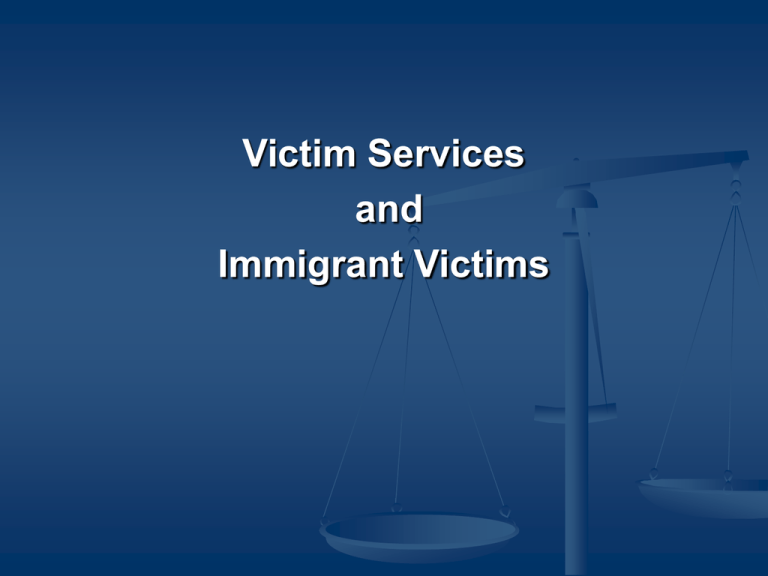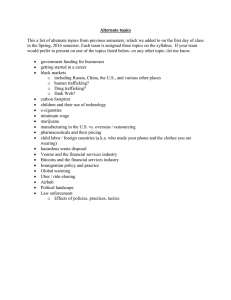
Victim Services
and
Immigrant Victims
Presentation Overview
Identifying crimes commonly committed
against non-citizens
Overview of immigration options for crime
victims
Human Trafficking: What Is It?
Human trafficking is a form of modern-day slavery
Victims of trafficking are exploited for commercial sex or
labor
Traffickers use force, fraud or coercion to achieve
exploitation
After drug dealing, human trafficking is tied with the
illegal arms trade as the second largest criminal
industry in the world, and it is the fastest growing.
Human Trafficking: What Is It?
Sex Trafficking: Commercial sex act induced by
force, fraud or coercion, or in which person
performing the act is under age 18.
Labor Trafficking: Using force, fraud or coercion to
recruit, harbor, transport, obtain or employ a person
for labor or services in involuntary servitude,
peonage, debt bondage or slavery
The crime of trafficking involves exploitation of the victim.
The physical movement of the victim is not required.
The TVPA protects both U.S. citizens and non-citizens.
Trafficking vs. Smuggling
TRAFFICKING
Must contain element of force
fraud or coercion (unless victim
under 18 and engaged in
commercial sex acts
Forced labor and/or exploitation
Need not involve actual movement
of the victim
No requirement of crossing an
international border
Victim must be involved in
labor/services or commercial sex
acts, i.e. must be “working”
SMUGGLING
Person generally consents to be
smuggled
No actual or implied coercion
Persons are free to leave, change
jobs, etc.
Must involve element of
transportation
Who Are Victims
of Human Trafficking?
Approximately 800,000 to 900,000 victims annually trafficked
across international borders worldwide; between 18,000 and
20,000 victims trafficked into United States annually.
More than half of victims trafficked into United States are
children; victims are probably about equally women and men.
Victims can be trafficked into the U.S. from anywhere in the
world. Within the U.S., both citizens and non-citizens fall prey to
traffickers.
Many victims in the U.S. do not speak English and are unable to
communicate with service providers, police, or others who might
be able to help them.
Mindset of Trafficking Victims
Frequently victims:
Do not speak English and are unfamiliar with U.S.
culture
Distrust outsiders, especially law enforcement – fear of
deportation
Do not identify as victims; often blame themselves for
predicaments
Although many victims have been beaten and/or raped,
current situation may still be better than where they
came from
May be unaware of rights or may have been
intentionally misinformed about rights in this country
Fear for safety of families in their home countries, who
are often threatened by traffickers
How Are Victims Trafficked?
Force, fraud and coercion are methods used by
traffickers to trap victims
into lives of servitude, abuse
Force: Rape, beatings, confinement
Fraud: Includes false and deceptive offers of
employment, marriage, better life
Coercion: Threats of serious harm to, or physical
restraint of, any person; any scheme, plan or pattern
intended to cause victims to believe that failure to
perform an act would result in restraint against them; or
the abuse or threatened abuse of the legal process.
Myths Associated with
Human Trafficking
Myth #1:
All Prostitutes
Are Willing Participants
Myths Associated with
Human Trafficking
Myth #2:
All Immigrants Smuggled into the
United States Enter Willingly
Myths Associated with
Human Trafficking
Myth #3:
Human Trafficking Is Crime
Prosecuted Only at Federal Level
Myths Associated with
Human Trafficking
Myth #4:
All Participants Involved in
Human Trafficking Are Criminals
Trafficking Victims Protection Act
(TVPA)
Signed into law October 2000
Prior to 2000, no comprehensive law to protect
victims of trafficking or to prosecute traffickers
Made human trafficking federal crime
Goals of law:
Prevent human trafficking overseas
Increase prosecution of human traffickers in United
States
Protect victims, provide Federal and state assistance
to victims
Trafficking Victims Protection Act
Law addresses three key areas:
Prevention
Protection
Public awareness and education
T visa, certification, benefits and services to help
victims rebuild their lives
Prosecution
New law enforcement tools and efforts
Summary of TVPA Provisions
Creates new laws that criminalize trafficking regarding slavery,
involuntary servitude, peonage or forced labor
Permits prosecution where non-violent coercion used to force
victims to work in belief they would be subject to serious harm
Permits prosecution where victim's service compelled by
confiscation of documents such as passports or birth certificates
Increases prison terms for all slavery violations from 10 years to 20
years; adds life imprisonment where violation involves death,
kidnapping, or sexual abuse of victim
Requires courts to order restitution, forfeiture of assets upon
conviction
Enables victims to seek witness protection, other types of
assistance
Gives prosecutors and agents new tools to get legal immigration
status for victims of trafficking during investigation, prosecution
TVPA Reauthorized in 2003
Federal government authorized more than
$200 million to continue domestic fight
against human trafficking
New law strengthens legal elements of TVPA
Sex and labor trafficking now considered offenses
under RICO statute
Encourages nation’s 21,000 law enforcement
agencies to investigate cases of trafficking
Texas Anti-Trafficking Law
Chapter 20A of Texas Penal Code
Forced labor or services defined: services are
obtained by threats of bodily injury; physical
restraint; threats to report a person to
immigration officials; or withholding a person’s
government records, identification or property
“Traffic” is defined as “means to transport,
entice, recruit, harbor, provide or otherwise
obtain another person by any means.”
TVPA and state law
Often traffickers break other state laws such
as:
Murder
Kidnapping
Battery
Assault
Sexual battery
False imprisonment
Prostitution
Promoting prostitution
Identifying Crime
of Human Trafficking
Non-verbal clues to link to human trafficking:
Living conditions of potential victims
Physical abuse
Working conditions
Restriction of movement indicators
Behavior indicators of severe dependency
Possession of other’s legal documentation
Possession of false or fraudulent documentation
Identifying Crime
of Human Trafficking
Look beneath surface of other crimes and
scenarios to expose crimes of human
trafficking:
Prostitution rings
(brothels, escort services, massage parlors)
Pornography
Illegal operations of massage parlors, strip clubs
Domestic abuse
Vice raids involving foreign nationals
Crimes involving immigrant children with no guardians
Identifying Crime
of Human Trafficking
Evidence of control and lack of ability to move freely or
leave job
Bruises or other signs of physical abuse
Intense fear or depression
Non-English speaking
Little or no knowledge of surrounding community
Lack of ID or immigration documents
Accompanied by another person who attempts to do all
the talking
Victims of Trafficking
and Their Needs
There are four general areas of victim needs:
Immediate assistance
Mental health assistance
Counseling
Income assistance
Housing, food, medical, safety and security,
language interpretation and legal services
Cash, living assistance
Legal immigration status
T visa or other immigration benefit, certification
Communicating with
Victims of Human Trafficking
Fear of deportation
Does not Identify as
Victim
Distrust of law
enforcement
Unaware of rights
The TVPA authorizes special visas
and other forms of immigration
relief to certain to trafficking
victims.
You are a victim, not a criminal.
What is happening to you is
wrong.
We can help get you what you
need. We can protect you. You
can trust us.
You have rights. You have the
right to live without being abused.
Identifying Victims of Trafficking
Key Questions for Victims of Trafficking:
How did you get here?
Where do you live, eat and sleep?
Do you owe someone money?
Is someone keeping your legal/travel documents?
Were you threatened if you tried to leave?
Has your family been threatened?
Were you ever physically abused?
Were you ever forced to stay in one place?
Who are you afraid of?
Immigration Remedies for
Trafficking Victims
Continued Presence
T visas
U visas
Continued Presence
Temporary permission to remain in the
U.S.
Parole/deferred action and employment
authorization
Must be requested by federal law
enforcement agency
Designed to keep potential victim in U.S.
during investigation
Access to public benefits
Requirements for T visa
Victim of severe form of trafficking (as defined in
TVPA)
Present in the U.S. on account of the trafficking
Not inadmissible or qualifies for waiver of
inadmissibility
Adult victims are required to comply with
“reasonable requests” to cooperate with law
enforcement. Certification by federal law
enforcement is helpful, but not required.
T Visa Benefits
Nonimmigrant status for 4 years, including
employment authorization
Possible to obtain status for derivative
family members
Can seek LPR status after 4 years
(although regulations still have not been
issued)
Access to public benefits for temporary
period of time
U Visas
Created in 2000 by the Battered
Immigration Women Protection Act of
2000 and amended by VAWA 2005
Regulations effective beginning
10/17/2007
Designed to assist law enforcement in
investigating and prosecuting crimes
Who qualifies for a U visas?
Available to certain crime victims who:
Suffered substantial physical or emotional
abuse as a result of having been a victim
of criminal activity;
Have information regarding the criminal
activity; and
Assist in the investigation and/or
prosecution of the crime
What crimes are recognized?
One or more of the following or any similar activity:
rape; torture; trafficking; incest; domestic violence;
sexual assault; abusive sexual contact; prostitution;
sexual exploitation; female genital mutilation; being held
hostage; peonage; involuntary servitude; slave trade;
kidnapping; abduction; unlawful criminal restraint; false
imprisonment; blackmail; extortion; manslaughter;
murder; felonious assault; witness tampering;
obstruction of justice; perjury; or attempt, conspiracy, or
solicitation to commit any of the above mentioned
crimes.
Who is a victim?
Direct Victims: suffered direct harm
Indirect victim:
Spouse, legal guardian, parent, child, sibling, another family
member, or person designated by the court when the direct
victim is deceased incompetent or incapacitated;
Parent or legal guardian of victim under the age of 18
Victims of witness tampering, obstruction of justice and/or
perjury must show direct or proximate harm and that the
perpetrator committed the act to avoid or frustrate efforts to
investigate, arrest or prosecute the perpetrator or that the
perpetrator committed the act to further abuse, exploit or
exercise control over the victim
Criminal Activity:
Must have violated U.S. law or have
occurred in the U.S. (including Indian
country and military installations) or the
territories and possessions of the U.S.
Includes crimes investigated or prosecuted
at the Federal, State or local level
Role of Law Enforcement for
U visas
Requires cooperation with law enforcement
(although a criminal prosecution is not
necessary)
Requires certification from law enforcement
stating that applicant has been helpful, is being
helpful, or is likely to be helpful in the
investigation or prosecution of a qualifying crime
Certification and therefore status can be revoked
if person stops cooperating w/ authorities
Approved applicants get:
Permission to remain in U.S. up to 4 years
Work authorization
After 3 years U visa recipients can apply to
adjust status
Applicants can request derivative status
for immediate family members
Building Partnerships
Victims are best served when law
enforcement, social service providers, and
legal service providers work together to
help victims recover.
This can be achieved through coalitions or
by informal networks when agencies
identify specific people who handle these
kinds of cases.
How you can help
If you suspect a person is entitled to one of
these forms of relief, make a referral to an
immigration attorney as soon as possible.
For more information on human trafficking
resources, or to report suspicious activity,
contact the National Human Trafficking
Resource Center at
1-888-3737-888
Prevent trafficking by promoting
awareness
TRLA is available to conduct trainings for
law enforcement, social service providers,
health care workers, and other people
who may come in contact with trafficking
victims and other crime victims. To
schedule a training, please contact:
Noemi Martinez, Outreach Coordinator
956 393-6219
Noemimartinez@trla.org
Questions
For more information contact:
Erica Schommer
Texas RioGrande Legal Aid, Inc.
300 S. Texas Blvd
Weslaco, TX 78596
(956) 447-4806
Eschommer@trla.org






